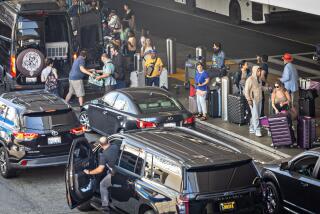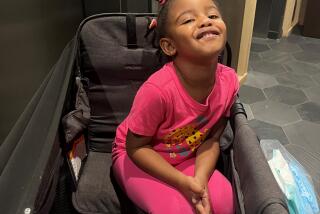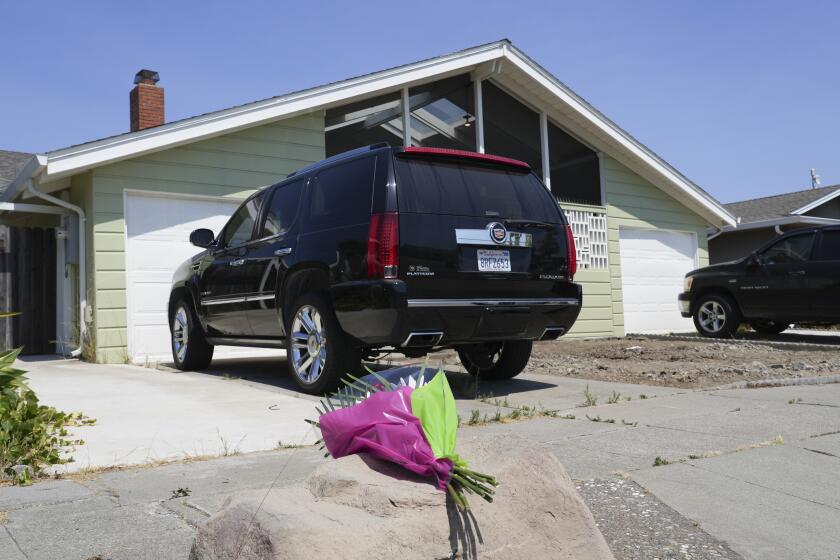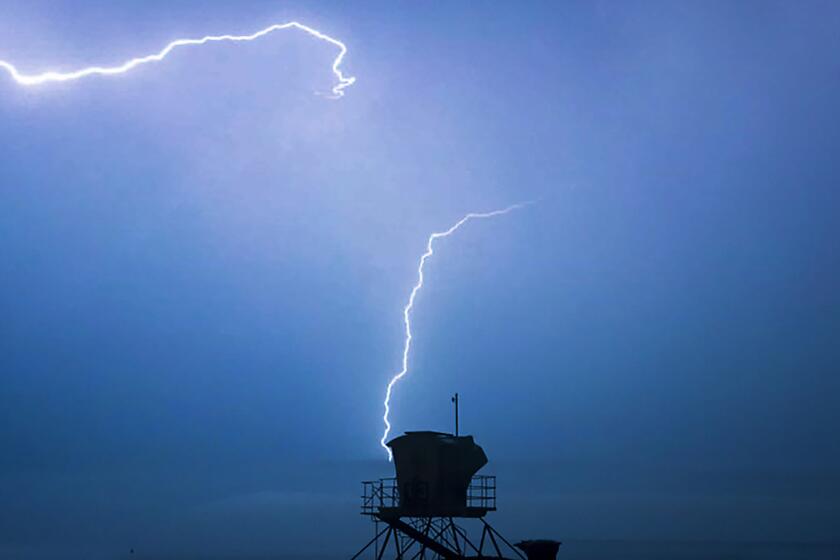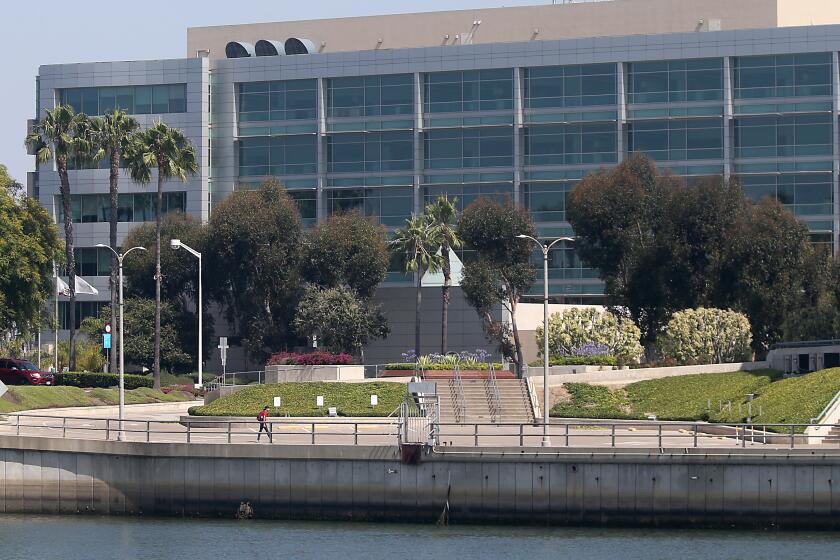At a Crossroads
A century and a half after first landing on these shores as cheap labor, people of Asian ancestry have become California’s best-educated and fastest-growing racial group.
Driven by a wave of immigration, the Asian American population has almost tripled since 1980. The community of 3.8 million--12% of the state’s population--is having an impact beyond its numbers, and is approaching a critical mass that promises to alter the way Californians work and play, shop and do business.
For a group that until several decades ago could not own land, testify in court, become naturalized citizens or marry freely, the record is striking. Asian Americans’ affluence and achievements have challenged the notion that to be a minority is to be disadvantaged.
They are the largest student group on top UC campuses and have the highest rate of obtaining advanced college degrees. They have started hundreds of high-tech firms, and own some of the biggest banks in the Los Angeles area. Their contributions to everyday life range from Play-Doh and Prozac to daisy-wheel printers and Bing cherries, from the music of Yo-Yo Ma to the novels of Amy Tan.
But greater numbers also have brought greater problems: Asian Americans have the fastest-rising welfare population and persistent gang activity. An undercurrent of racial tensions, friction between Asian newcomers and natives, intergenerational conflicts and a nagging identity crisis afflict the community.
And Asian Americans say that they do not feel fully vested in America’s social, corporate and political life. They often are made to feel like foreigners, no matter how long their families have been here.
“On one hand, we have been successful in high tech, in education, science and several other fields,” said historian L. Ling-chi Wang of UC Berkeley. “But on the other hand, we remain a minority in the eyes of the majority, and America continues to view Asian Americans not as an integral part of its identity, society and culture.
“That’s where the uniqueness of Asian Americans really is.”
The government projects that by 2000 there will be nearly 5 million Asian Americans in the state, the most in the nation. And, experts say, millions of Californians will have Asian American employers and landlords, and Asian tongues will be languages of commerce as ties to the Pacific Rim grow stronger.
The concept of an “Asian American” is a recent invention, widely used by demographers to make sense of ethnic changes and by community leaders to help instill a sense of pride and unity. The term was coined by UCLA historian Yuji Ichioka in the late 1960s.
Many question now whether it adequately describes a diverse people whose family origins extend from East Asia and Southeast Asia to the Indian subcontinent, as well as the Philippines and Indonesia.
The label embraces more than 30 ethnicities--some with historical animosities--and scores of languages. They range from fourth- and fifth-generation Japanese and Chinese Americans to Southeast Asian refugees and transnational “astronauts,” who commute between California and Asia.
Increasingly, the traditional lines of nationality and culture are blurred by the constant interchange with Asia in what futurologist John Naisbitt calls the “new global configuration.”
“Asian Americans, as well as Asians who are educated and have worked in America, will be a bridge between the East and the West,” he wrote in his 1996 book, “Megatrends Asia.”
“Having lived in both worlds, they will act as mediators and interpreters for business and political communities that are so interrelated that national and regional boundaries are irrelevant.”
They also are turning upside-down conventional concepts of what it means to be a minority in America. Many Asian Americans have been able to compete in the marketplace because of their high educational attainment, professional skills and business acumen.
“The old-fashioned scenario [is], ‘Here come all those Asian immigrants, and now they are going to spend the next generation adjusting to America,’ ” said state librarian Kevin Starr, an authority on California history. “Forget it. They get off the plane at Los Angeles International Airport [and] two days later, they’re creating jobs and wealth for people.”
Asian Americans also are struggling over issues that will help shape California in the 21st century, when no single racial group will be a majority.
Their rising numbers, and even their successes in the classroom and the business community, have at times engendered envy and resentment among other groups.
So many have blended into the middle class that some fear that the cultural identity of Asian Americans is in danger of vanishing. The concern is particularly acute for people of Japanese descent, who have the highest rate of intermarriage with other ethnic groups.
Marriage between Asians and non-Asians has been rising steadily in the past three decades, resulting in a proliferation of racially mixed Asian Americans.
“Asian Americans have become a crucial barometer of the contemporary racial climate,” said UC Berkeley sociologist Michael Omi.
Approaching Critical Mass
“Asian Americans are making a tremendous impact in California’s landscape--both social and economic.”
--Former UC Berkeley Chancellor Chang-Lin Tien
*
In ways subtle and striking, Asian Americans are influencing everything in California from food to commerce to entertainment.
Flip through the central Los Angeles telephone directory, and you’ll see six pages of Kims, compared with four of Smiths and 5 1/2 of Lopezes. Trips along Atlantic Boulevard in the San Gabriel Valley, Bolsa Avenue in Westminster’s Little Saigon, or Olympic Boulevard in Koreatown evoke the sights and smells of Taipei, Hanoi or Seoul.
Many major Southland supermarkets stock Japanese sushi, Korean kimchi (pickled cabbage), Chinese greens and Indian spices. Non-Asian youngsters from the suburbs frequent amusement arcades in Little Tokyo and read Asian comic books.
An Eastern approach to management--involving values such as seeking consensus and nonverbal communication--increasingly is being embraced by companies that do business with Pacific Rim firms.
Asian Americans who can move easily in several cultures and languages have become valuable bridges to Asian economies. For instance, George Koo, past chairman of the 700-member Asian American Manufacturers Assn., has a thriving Silicon Valley consulting business helping U.S. companies in Asia.
In some areas, real estate agents allow for a feng shui expert to ensure a site and building are in harmony with nature before a deal is closed with people of Chinese ancestry. Developers who cater to wealthy Asians sometimes design homes with this in mind.
“It’s a two-way street,” said Edward T. Chang, professor of ethnic studies at UC Riverside. “People tend to view assimilation as a one-way street of immigrants adapting to the dominant society, but they don’t recognize the other spectrum--of natives being changed [by immigrants].”
Hundreds of Asian American congregations have taken over or share quarters with traditional Christian churches in Southern California. Groups such as Asian Promise Keepers and Campus Crusade for Christ are attracting young Asians by the thousands.
And an Asian theology has emerged that interprets the Bible in the context of Asian history and experience, according to Syngman Rhee, a professor at Union Theological Seminary in Richmond, Va.
“Asian American Christian presence and participation are very important, both in tangible and intangible ways,” said Rhee, president in 1992 and 1993 of the National Council of Churches. He was the first Asian American to lead the organization representing 34 major denominations and 50 million people.
At elite universities, where they once benefited from affirmative action but now are overrepresented, Asian Americans have had an impact on student life and the curriculum. Chinese and Japanese are among the six most popular foreign language courses in college. The SAT IIs, which are used in admissions, include achievement tests for those who studied Japanese, Chinese and Korean.
In banking, five of the 10 biggest banks in Los Angeles County are Asian- or Asian American-owned, according to industry sources.
“We bridge a gap between California and Asian countries, in providing financial services and lending services,” said Li-Pei Wu, chief executive officer of General Bank in Los Angeles.
In the health and science fields, Asian Americans have pursued cutting-edge research. Professors Chih-Ming Ho of UCLA and Yu-Chong Tai of Caltech are refining technology with uses ranging from disease diagnosis to reduction of drag on airline wings.
The emerging importance of Asian Americans is most evident in California’s high-technology industry, the wellspring of much of the state’s economic revival. A third of the Silicon Valley work force is Asian American.
Although Asian Americans generally have stalled in the middle management ranks of major U.S. corporations, many have become executives in high-tech companies.
John S. Chen, 42, is president and chief executive of Sybase Inc. of Emeryville, a $1-billion-a-year software company with 6,000 employees. Ko Nishimura, 59, is chairman, president and CEO of Solectron Corp., a Milpitas-based electronics firm with 18,000 employees and $3.7 billion in revenues last year.
Times are changing, said Chuck K. Chan, 47, founding partner of Alpine Technology Ventures, a venture capital firm based in Cupertino. The prevailing stereotype, he said, was that “Asians are quiet. Their language is bad and they cannot write English properly.”
“Our generation is crossing the language, cultural and perception barriers of being pigeonholed [and is gaining] wide acceptance.”
New Immigrants Lead the Way
Being an American can mean different things to different people, but . . . each experience contributes to the national story and each achievement leads the nation forward.
--Bill Ong Hing, author of “To Be an American: Cultural Pluralism and the Rhetoric of Assimilation”
*
Chang-Lin Tien, the first Asian American to head a major university, had been a popular UC chancellor for a year when a supporter congratulated him on a job well done.
Then he broached the subject of Tien’s Chinese accent. He offered to pay for “linguistic surgery” to eliminate Tien’s accent through speech lessons.
“It presented a real dilemma for me,” Tien recalled. “I didn’t want to make that person feel uncomfortable, yet I wanted to convince him that I liked my accent. It’s part of my identity.”
Eventually, the chancellor’s accent became as much of a hallmark as his ebullient personality.
Tien, who was born in China and emigrated from Taiwan, is not alone. Two-thirds of Asian Americans are foreign-born, and many speak with an accent.
Most came after passage of the 1965 amendments to the Immigration and Nationality Act, which allowed more Asians to enter the country. The law permitted families to reunite and heralded an influx of doctors, scientists and other professionals.
The immigrants diversified the predominantly American-born population and helped create significant new Asian American middle and upper classes.
In June, when the Committee of 100, an exclusive group of Chinese Americans, held its national convention in the Silicon Valley, it honored four entrepreneurs and executives who all happen to be immigrants: Chen of Sybase; Pauline Lo Alker, president and CEO of Network Peripherals; Jerry Yang, founder of Yahoo!; and Albert Yu, senior vice president of Intel Corp.
Many immigrants brought 2,500-year-old Confucian values of respect for learning, family and authority.
Along with “study, study, study,” they admonish their children not to bring “shame” to the family and their race. They also want their children to be bicultural and bilingual, well-positioned for what some predict will be the Pacific Century.
Instead of watching cartoons on Saturday mornings, tens of thousands of youngsters attend language schools, where they learn their ancestral culture.
Angie Chang, who will be a sixth-grader at Wilson Elementary School in San Gabriel, has been attending Korean school every Saturday since first grade. Her fluency enables her to talk to her grandmother and enjoy Korean TV shows.
Her favorite video, “Six Siblings,” is a drama about a widow raising six children in poverty-stricken Korea in the 1960s. It has given her an appreciation for her life in America. “It tells you how poor Korea was and how much people suffered and how lucky we are,” she said.
Before the Asian American population boom, young Asians often avoided speaking their parents’ language outside the home because they were ashamed or were concerned that they would not be accepted as Americans.
“There was this kind of enforced Americanization that was held up as an ideal,” said UCLA’s Ichioka. “You were supposed to get rid of your parents’ language, dump your old culture and traits, and make yourself in the image of Anglo-Saxon, New England Americans.”
Now, some students on UC campuses combine other majors with Asian American studies. Many take time off to study and live in Asia.
“They are Americans but there is something that doesn’t satisfy them,” said Henry Der, deputy state schools chief and former head of Chinese for Affirmative Action. “Why do they feel like they have to go through Asian routes? What compels Asian groups to form on campuses?”
Seeking Power in Politics
They used to think politics was dirty. You’d never see an [Asian] engineer or a computer scientist on a weekday night, sitting in a political meeting. Now you do.
--David E. Lee, executive director of the Chinese American Voters Education Committee
*
Asian Americans scripted the 1996 elections as the political coming out for a group that had long felt marginalized. They registered more than 75,000 new voters, bringing the total to 1.3 million nationwide--split almost evenly among the two major parties and independents.
They gave more money than ever to both Democrats and Republicans. And they hoped for at least one Cabinet post.
There were no Cabinet appointments, but a dozen figures of Asian descent were caught up in the Democratic fund-raising scandal.
Instead of driving Asian Americans away, the painful episode appears to have politically energized the community.
More Asian Americans than ever sought federal, state and local offices in California’s June primary, including congressional seats. And a similar increase was evident elsewhere in the country.
Of the 24 candidates in California, 14 won nomination, prompting Harold Fong, chair of the Asian Pacific American caucus of the state Democratic Party, to say the showing “speaks volumes of the growing political strength and maturity” of the community.
For the first time, Asian Americans, now 6% of the state’s voters, felt they could affect a statewide race. Taking advantage of California’s first blanket primary,many crossed party lines to vote for Treasurer Matt Fong, who won the GOP’s U.S. Senate nomination.
“Though many Asian Americans lost, we all won as they hit the campaign trail, trampling the stereotype of us as a passive, quiet, apolitical people who do not take democracy seriously,” said commentator Phil Tajitsu Nash in AsianWeek.
Asian Americans, who have the largest percentage of independent voters of any ethnic group, are conducting much of their political activity outside the major parties. And much of their new vigor comes from immigrants, often small-business people who vote their pocketbook and interests.
“Immigrants are not intimidated by the dominant culture,” said Lee. “They are doing the stuff that [the] American-born have never done.”
There are not many locales where Asian Americans can swing an election, because their population tends to be scattered, from cities to suburbs.
San Francisco, where Chinese settled during the Gold Rush era, is an exception. The influx of Asian immigrants has spawned new Chinatowns along Clement and Irving streets in the once-white western reaches of the city.
Asian Americans represent a third of the population and 18% of registered voters. They hold three spots on the Board of Supervisors, own 25% of the real estate, and make up more than half of the school population.
The new arrivals are challenging the city’s liberal Democratic power structure, including Asians who are part of it.
Last year, two Chinese American immigrants--Rose Tsai and Julie Lee--led the November ballot drive to rebuild the quake-damaged Central Freeway.
Despite opposition from major political players, including the Chinese American Democratic Club and the Chinese Chamber of Commerce, the self-described housewives got Proposition H passed.
The vote represented a significant moment in Chinese American political history, wrote columnist William Wong in the San Francisco Examiner. “The political temblor was generated by a ragtag army of Chinese American immigrants who had the audacity to defy City Hall, Mayor [Willie] Brown, downtown business interest, gay-lesbian groups, environmentalists and assorted liberals.”
The city’s activists have an advantage. Unlike Los Angeles--where Chinese, Filipinos, Japanese and Koreans form sizable groups--San Francisco is dominated by ethnic Chinese. This makes it easier to organize and to communicate.
“If we can’t make it in San Francisco, we can’t make it anywhere,” Tsai said.
After the fund-raising scandal erupted, community leaders across the nation moved to start a counterpart to the National Assn. for the Advancement of Colored People.
This “pan-Asian movement” could unite the various communities, leaders said, and help translate Asian Americans’ economic clout and high degree of education into political might.
“Asians, more than any other immigrant group of its size, are poised to mature politically,” said Lee of the voter education project.
“We see professionals who had never voted before, highly educated people from Taiwan and engineers in the Silicon Valley joining clubs and organizing their neighborhoods.”
Fearing Loss of Identity
We need to be more accepting of the differences within our own ethnic group . . . Some Japanese Americans don’t look Japanese American at all.
--Bill Watanabe, executive director of Little Tokyo Service Center
*
After five generations in the United States, with only a trickle of immigration to help replenish its population, the Japanese American community is at a crossroads.
The first-generation issei mostly are deceased. The second-generation nisei mostly are retired. The third-generation sansei are in charge. They are heavily assimilated. Half of those who are married have non-Japanese spouses, and they maintain relatively few ties to cultural and religious institutions that helped hold the community together for nearly 120 years.
They have not been California’s largest Asian group since 1970. By 1990, they had dropped to third, behind Filipinos and Chinese.
Now, a decade after World War II internees won reparations, many fear Japanese Americans will lose their cultural identity entirely. Attention is turning to preserving the community’s history. Work has started on a $45-million expansion of the Japanese American National Museum in Little Tokyo.
Community groups also are organizing national conferences on ways to tap the ties that bind this geographically dispersed group.
“We have no choice but to be more inclusive--to include Japanese Americans of mixed ancestry, postwar immigrants, and others who make up the diversity of our community,” said Al Muratsuchi, a former official of the Japanese American Citizens League.
With Japanese Americans intermarrying at the rate of 50% in cities and 70% in rural areas, Japanese Americans often look white, Latino or black. For almost two decades, studies show, families with one Japanese parent have exceeded the number of families with two Japanese parents.
While some contend that intermarriage is hastening the community’s demise, others say the trend is a part of the American passage.
“Instead of looking at interracial marriage as an end of the Japanese American community, we should extend the definition,” suggested Rebecca Chiyoko King, a San Francisco sociologist, who is half Japanese and half white.
She was awakened to her ethnic heritage as a first-grader at a friend’s home in a Chicago suburb.
Young Rebecca was shocked when her friend’s mother served hot dogs with “yellow and red” stuff on top.
“When you grow up with shoyu [soy sauce] hot dogs, you don’t think of other peoples’ hot dogs,” said King.
For Curtiss Takada Rooks, whose father is African American and whose mother is an issei, lessons of dual heritage also came early.
“You had to look Dad in the eyes when he talked, but with Mom, you didn’t,” he said, explaining different norms of civility.
“As a hapa [half], I claim Japanese American-ness,” said Rooks, who teaches American culture at Loyola Marymount University.
In the 21st century, a typical Japanese American will be of mixed race, predicts Greg Mayeda, president of the Hapa Issues Forum, a Bay Area-based organization of racially mixed Asians. “They can have freckles and light brown hair and nontraditional Japanese names, but they will still be considered full-fledged members of the Japanese American community.”
Others lament intermarriage because it dilutes their culture and could result in the loss of traditional values such as enryo, or self-restraint.
The Japanese American community faces an important choice, said Chris Komai, whose grandfather was the publisher of Los Angeles-based Rafu Shimpo, the oldest Japanese American newspaper in the continental U.S.
“Do you want to remain attached to each other? If we do, how?”
The Rich and the Invisible Poor
Poor Asians, like poor Jews, seem like a contradiction. Yet, it’s the reality.
--Don T. Nakanishi, director of the UCLA Asian American Studies Center
*
No racial group in California offers such stark contrasts of affluence and poverty, education and illiteracy.
The 1990 census shows that Asian Americans had the highest percentage of households with annual incomes of $75,000 or more--slightly ahead of whites. People of Asian Indian heritage, whose English proficiency and education levels are high, led the way.
People of Asian ancestry had a median household income of $42,960 by 1997--higher than any racial group except whites.
But Asian Americans are also the fastest-growing segment on welfare. The rate of households on welfare has climbed from 9.7% to 12% since 1980.
A sizable segment of the community, particularly Southeast Asian refugees, lives in dire poverty. And, although about 40% of Asian Americans have college or postgraduate education, one in seven lacks a high school diploma.
They are part of the invisible poor who shatter the “model minority” label so often attached to Asian Americans.
“On one hand, we have people who are really moving up on the economic ladder, and on the other, we have some groups that are really stuck,” said Stewart Kwoh, president of the Asian Pacific American Legal Center.
Although Asians on welfare come from all the ethnic subgroups, about one in three Southeast Asians receives public aid. More than two-thirds of Cambodians and Laotians are on the rolls.
Many Southeast Asian refugees were uprooted from villages, ill-prepared for urban life in the West. In America, their family foundations are shaken, especially when male heads of household are emasculated by inability to find work and other problems.
“Back home in Laos, the husband has the authority in the family,” said Leo Pandac, who runs a drug and alcohol treatment program near downtown. “With Americanization of children and the wife, the husband doesn’t wield the same influence.”
For example, Pandac said that when domestic violence erupts, the wife often calls the police and the husband gets arrested, undermining his authority.
More than 1 million Southeast Asian refugees arrived in the United States between 1975 and 1991, starting with the Vietnamese after the fall of Saigon.
Many don’t have much in common with other Asian Americans. For example, there is little to connect a Cambodian refugee in Long Beach’s Little Phnom Penh and a Monterey Park doctor from Taiwan.
Asian Americans from many walks of life, from grocery store owners to high-tech executives, are coming to realize their community needs to be concerned not only about impoverished Asians, but also about the rest of California’s multiethnic society.
“Our emphasis on education, hard work and the family has brought us far, despite racism,” said retired appellate Judge Harry W. Low, the former president of the century-old Chinese American Citizens Alliance.
But Low and others maintain that Asian Americans need to foster community involvement to become part of the nation’s civic culture.
“When you contrast the Jewish and Asian ethos, we have a glaring absence of public sense of charity to others, which comes from the Judeo-Christian heritage,” said K.W. Lee, former editor of the Korea Times English edition. “Call it community conscience, social conscience or civic conscience, we need that. That’s the final rite of passage in the long journey of Asians in America.”
Improving relations with other races remains perhaps the most daunting challenge in California, where anti-Asian discrimination dates to the violent backlash last century against Chinese laborers who were scapegoated over depressed wages and unemployment.
More recently, Asian business owners, particularly those of Korean descent, suffered some of the heaviest losses in the 1992 Los Angeles riots. And Asian Americans continue to be one of the groups targeted for hate crimes.
“Asian Americans cannot shape the future of California without significantly relating with Latinos and blacks,” said Berkeley historian Wang. “Our future lies in our ability to work jointly to create a new America where we can create a new identity.”
MONDAY: Teens Search for Identity
Editor’s Note: The Times has expanded on its traditional Sunday Column One with Sunday Report, a weekly story distinguished by depth of reporting.
The complete series will be available on The Times’ Web site beginning Wednesday. Go to: https://www.latimes.com/asian
(BEGIN TEXT OF INFOBOX / INFOGRAPHIC)
About This Series
As California’s fastest-growing ethnic group, Asian Americans find greater numbers bring greater successes and greater problems.
Today: They are influencing everything from cuisine to commerce, while struggling to become fully vested in American life.
Monday: Teens face a double identity crisis--battling the usual conflicts of adolescence while defining themselves in two cultures.
Tuesday: An Asian American enrollment boom is transforming the nation’s top universities.
Wednesday: In the corporate world, Asian Americans often stall in the middle ranks, but there are cracks in the glass ceiling.
(BEGIN TEXT OF INFOBOX / INFOGRAPHIC)
Asian Americans in California
People of Asian ancestry are the fastest-growing and most diverse group in the United States. Nearly 40% of the nation’s 10 million Asian-Americans live in California, where they make up 12% of the population. Immigration accounted for more than half of their population growth in the 1990s.
Population Profile, 1997
Asian Americans in California have the highest proportion of college graduates of any ethnic group. They also have the highest median income and the lowest welfare rate among minorities.
Population totals (in millions)
Asian Americans: 3.8
African Americans: 2.0
Latinos: 9.2
Whites: 17.3
****
Household income
Median
Asian Americans: $42,960
African Americans: $31,110
Latinos: $26,766
Whites: $48,590
****
Percentage of households on welfare
Asian Americans: 12%
African Americans: 17.9%
Latinos: 14.7%
Whites: 4.7%
****
Percentage over age 25 . . .
. . . who are college graduates
Asian Americans: 40.9%
African Americans: 20.3%
Latinos: 8%
Whites: 33.2%
****
. . . without a high school diploma
Asian Americans: 14.3%
African Americans: 14.6%
Latinos: 51.7%
Whites: 8.2%
****
Citizenship
Percentage who are U.S. citizens
Asian Americans: 68.7%
African Americans: 97.6%
Latinos: 60.8%
Whites: 95.8%
****
Percentage born in U.S.
Asian Americans: 36.3%
African Americans: 94.8%
Latinos: 52.9%
Whites: 91%
****
Immigration to California
1990
In the last census, 2.7 million of the state’s 30 million people were Asian Americans.
Chinese: 26%
Filipino: 26.7%
Asian Indian: 5.6%
Korean: 9.5%
Japanese: 11.7%
Vietnamese: 10.1%
* Other Asian: 10.4%
****
1990-96
A wave of 600,000 Asians immigrated to California.
China: 17.3%
Philippines: 28.9%
India: 7.9%
South Korea: 6.8%
Japan: 2.4%
Vietnam: 21.6%
Taiwan: 4.2%
* Other Asian: 10.9%
****
1997
Immigration and births pushed the Asian American population to 3.8 million, about 12% of the state.
White: 52.7%
Latino: 28.4%
Black: 6.4%
Asian American: 11.9%
Other: 0.6%
****
Immigrants by County
Asian immigrants in the 1990s dispersed throughout the state. Chinese and Filipinos accounted for most of the new arrivals in Los Angeles County, while almost 60% of the immigrants to Orange County were Vietnamese.
Los Angeles
Total Asian immigrants: 171,551
Chinese: 27.9%
Filipino: 31.3%
All other Asian: 40.8%
****
Orange
Total Asian immigrants: 74,915
Vietnamese: 58.9%
Chinese: 11%
All other Asian: 30.1%
* Category “Other Asian” includes people from Cambodia, Laos, Thailand, Bangladesh, Myanmar, Indonesia, Malaysia, Okinawa, Pakistan, Sri Lanka and others as defined in the 1990 census.
Data analysis by Times director of computer analysis RICHARD O’REILLY and analyst SANDRA POINDEXTER
Sources: 1990 U.S. Census, Current Population Surveys, 1994-97, and U.S. immigration data, 1990-96.
Asian American Snapshots
POPULATION: Filipino Americans are the largest group of Asians in California, with a population of 734,000 in 1990.
HOUSEHOLD INCOME: Those from the Phillipines and India had the highest median income, about $45,000.
EDUCATION: Adults of Japanese heritage are the Asian Americans most likely to have a high school diploma.
COLLEGE: Almost half of Indian Americans over age 24 have college degrees.
WELFARE: Southeast Asian refugees have the highest welfare rate, Japanese Americans the lowest among Asian groups.
YOUTH: More than half of the Hmong people in the U.S. are 12 or younger.
AGING: Japanese Americans are the oldest group; 19% are at least 60.
ENGLISH: More than 93% of Filipino Americans speak English fluently.
PROFESSIONS: Filipino Americans have the highest percentage of workers (22%) in professional fields, Korean Americans the highest (30%) in retail trade.
HOME OWNERSHIP: Americans from Taiwan have the highest level of home ownership, 79%.
More to Read
Start your day right
Sign up for Essential California for news, features and recommendations from the L.A. Times and beyond in your inbox six days a week.
You may occasionally receive promotional content from the Los Angeles Times.
